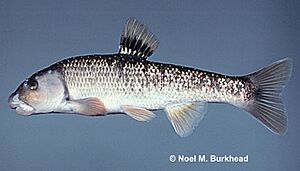Largescale stoneroller facts for kids
Quick facts for kids Largescale stoneroller |
|
|---|---|
 |
|
| Conservation status | |
| Scientific classification |
The largescale stoneroller (scientific name: Campostoma oligolepis) is a type of fish. It belongs to the Cyprinidae family, which includes minnows and carps. This fish naturally lives in the eastern parts of the United States.
Contents
Where Largescale Stonerollers Live
The largescale stoneroller lives in many different waterways across North America. You can find them in streams, rivers, lakes, and creeks. They are native to areas like the Upper Mississippi River and Lake Michigan. This includes parts of Wisconsin, eastern Minnesota, eastern Iowa, and northern Illinois.
They also live in streams in central and southern Missouri, and northern Arkansas. Other native homes include the Mobile Bay area in Georgia, Alabama, and eastern Mississippi. You can also find them in parts of the Green, Cumberland, and Tennessee River systems in Kentucky, Tennessee, Georgia, and Alabama.
Sometimes, these fish are introduced to new places. For example, they have been found in the Illinois River in Oklahoma. Scientists think this happened because people use them as baitfish for fishing. When used as bait, some fish can escape and start living in new areas. Researchers are still studying what effects these introduced fish might have on their new homes. Overall, the largescale stoneroller's range stretches from Alabama all the way to Oklahoma.
What Largescale Stonerollers Do
Largescale stonerollers like to live in water that has plenty of oxygen. They prefer calm areas with slow-moving water. They also like to live in higher elevation habitats, away from the flat coastal plains.
These fish are herbivores, which means they mainly eat plants. Their diet includes tiny plant-like organisms called diatoms, green algae, and blue-green bacteria. They tend to eat less sand and mud compared to some other stoneroller fish.
Largescale stonerollers have several predators. Larger fish like the largemouth bass, smallmouth bass, spotted bass, sauger, and walleye all hunt them. Since they are popular baitfish, people who fish also catch them. These stonerollers can handle some polluted water. This means they don't have many other fish competing with them for food or space in those areas.
Largescale Stoneroller Life Cycle
Largescale stonerollers usually become old enough to reproduce when they are one to four years old. Their breeding season starts in late winter. During this time, the male fish build nests. They use gravel bars and rocks to create these nests.
In the spring, the female fish arrive and lay their eggs in the nests. The males then fertilize the eggs. A single female can lay a lot of eggs, sometimes from 400 to 4,000 at once! After the eggs are laid and fertilized, both the male and female fish leave the nest. They don't stay to guard the eggs or the young.
The baby fish, called fry, hatch on their own. They learn to take care of themselves. These fry often stay together in a group called a school. This helps them find food and protect each other from predators. A largescale stoneroller typically lives for about five years.
Protecting Largescale Stonerollers
The largescale stoneroller is not currently listed as an endangered or threatened species by the government. This means their numbers are stable and they are not at risk of disappearing.
As mentioned before, these fish have been found in new places, like the Illinois River in Oklahoma. Scientists believe they were introduced there by humans. Even though they are now in new areas, researchers have not yet seen any major positive or negative effects on the plants and animals living there.



